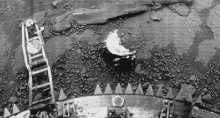One Russian scientist thinks so
Leonid Ksanformaliti, a scientist with the Space Research Institute of the Russian Academy of Sciences, has been closely examining some 30 year-old footage from a Soviet probe's landing on the surface of Venus. And in a recently published paper, Ksanformaliti drops a bomb: there is life on Venus, large life which is sufficiently organized to be disturbed (if not frightened away) by the landing of the Soviet probe.
Venus stands between us and the Sun, and can often be seen in the sky (typically right before or right after sunrise). Venus has a similar size, composition, and gravity compared to Earth. But life on Venus would be harsh indeed. It has no water, although it seems that it did at one point in the distant past.
All of Venus' water evaporated long ago due to a "runaway greenhouse effect" provided by its incredibly dense atmosphere, which is almost entirely carbon dioxide (topped with a thick layer of sulfuric acid). The surface of Venus is just rock, slab-like gray rock, dotted with the occasional volcano. Because of the density of the atmosphere, atmospheric pressure at the surface level is approximately 92 times higher than that on Earth.
Both the Soviets and the United States began exploring Venus in the early to mid 1960s. In 1982 the Soviets landed their Venus-13 landing probe, which sent back a 126-minute panoramic video. Ksanformaliti has been studying this video carefully, and he claims to have found several animate objects - creatures? - which were initially overlooked in Soviet studies of the footage.
Ksanformaliti's scientific article mentions three objects which he says "have the qualities of human beings." He has dubbed these items the "shape-shifting disk," the "black patch," and the "scorpion." The scorpion is particularly interesting since, unlike the other shapes which are there when the probe lands, it only appears after the probe has been on the surface for 26 minutes. The objects are between 4 and 16 inches long, large enough that Ksanformaliti is convinced they are not technical glitches or visual artifacts.
Certain killjoys and expert image processors, like Jonathon Hill who works with NASA's Mars missions, assert that the shapes have more mundane explanations. Hill says the crab-like half-disk is a camera lens cover which was designed to pop off once the probe landed. Ted Stryk, a professional photo editor who also works with NASA data, says that the "scorpion" is not present in the original footage, and that it is simply a blur left over from processing noise in low-quality versions of the footage.
(But won't they be surprised when the Venusian scorpions come knocking?)
